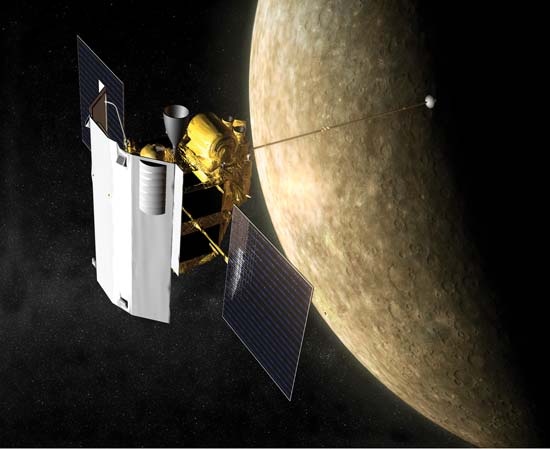Messenger
American racehorse
(foaled 1780), racehorse who, though a Thoroughbred who sired many successful Thoroughbred (flat) racers, was most important as the foundation sire of the Standardbred (harness racehorse) breed. A son of Mambrino and grandson of Matchem, he was foaled in England but was taken to Philadelphia in 1788. His descendants became known for their trotting ability, and his great-grandson Hambletonian is the ancestor of most modern trotters.
United States spacecraft
in full Mercury Surface, Space Environment, Geochemistry, and Ranging
 U.S. spacecraft designed to study the surface and environmental properties of Mercury. The name was selected in honour of ancient Greek observers who perceived Mercury in its 88-day orbit of the Sun and named it for the messenger of the gods (Hermes, known to the Romans as Mercury).
U.S. spacecraft designed to study the surface and environmental properties of Mercury. The name was selected in honour of ancient Greek observers who perceived Mercury in its 88-day orbit of the Sun and named it for the messenger of the gods (Hermes, known to the Romans as Mercury).Messenger was launched on Aug. 3, 2004, by a delta II rocket from Cape Canaveral, Fla. Its first flybys were of Earth, on Aug. 2, 2005, and of Venus, on Oct. 24, 2006, and June 5, 2007. The first two Mercury flybys happened on Jan. 14 and Oct. 6, 2008, and a third was scheduled to take place on Sept. 29, 2009. During the fourth encounter, on March 18, 2011, a thruster maneuver is scheduled to insert Messenger into a 200 × 15,193-km (124 × 9,420-mile) orbit around Mercury. Over the next Mercury year (88 Earth days), Messenger's orbit is expected to be adjusted by solar tidal effects until two final burns trim the orbit to 200 km high and 12 hours long. The nominal mission then would last one year. Messenger was the first mission to Mercury since the flybys of Mariner 10 in 1974.
Instruments on Messenger include a laser altimeter that will profile the surface of Mercury and a dual-imaging system with wide-angle and telephoto optics and filters that span wavelengths from violet light to the near infrared. Other instruments will measure particles in Mercury's magnetosphere, X-rays (X-ray) and gamma rays (gamma ray) produced by cosmic ray collisions with the surface, and magnetic fields (magnetic field).
 Messenger's first flyby of Mercury revealed that the planet's craters are only half as deep as those of the moon. Mercury's Caloris impact basin (Mercury), one of the youngest and largest impact features in the solar system, was found to have evidence of volcanic vents. Messenger also discovered lobate scarps, which are huge cliffs at the top of crustal faults. These structures indicate that the planet, as it cooled early in its history, shrank by a third more than what had previously been believed.
Messenger's first flyby of Mercury revealed that the planet's craters are only half as deep as those of the moon. Mercury's Caloris impact basin (Mercury), one of the youngest and largest impact features in the solar system, was found to have evidence of volcanic vents. Messenger also discovered lobate scarps, which are huge cliffs at the top of crustal faults. These structures indicate that the planet, as it cooled early in its history, shrank by a third more than what had previously been believed.- Peter O'Toole
- Pete Rozelle
- Peter, Paul and Mary
- Peter Paul Rubens
- Peter Payne
- Peter Peregrinus of Maricourt
- Peter Philips
- Peter Pindar
- Peter Porter
- Peter Rochegune Munch
- Peter Rosegger
- Peters, Brock
- Petersburg
- Petersburg Campaign
- Peters, Carl
- Peter Scheemakers
- Peter Schöffer
- Peter Seeberg
- Peter Sellers
- Peters, Ellis
- Peter Serkin
- Peter Simon Pallas
- Peter Singer
- Peter Skene Ogden
- Peters, Lenrie